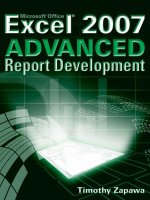Chapter 1: Choosing the Right Report Development Tool
Bạn đang xem bản rút gọn của tài liệu. Xem và tải ngay bản đầy đủ của tài liệu tại đây (234.45 KB, 14 trang )
Report Development Tools 1–1
Chapter 1: Choosing the Right Report
Development Tool
Contents
Choosing the Right Reporting Tool: The Big Picture.........................................1–2
Organization of Report Development Tools ........................................................1–3
Using the Application Hierarchy...........................................................................1–6
Using the Tools Summary Matrix..........................................................................1–9
Using the Tool Summaries ..................................................................................1–11
Learning More About Report Development Tools ............................................1–12
Review ...................................................................................................................1–13
1
In this chapter you will learn
how to:
Choose the right report
development tool for your
needs
Identify report
development tools that
support application areas
in Release 4.0B
Use the Tools Summary
Matrix to evaluate
different report
development tools
Chapter 1: Choosing the Right Report Development Tool
Choosing the Right Reporting Tool: The Big Picture
Reporting Made Easy
1–2
In Fundamentals of Reporting, the first book of this three-volume guidebook series, we
presented a methodology to help you choose a report development tool that fits your
reporting needs. Chapter 6 (book 1) showed how the process of selecting the right report
development tool is an integral part of the tactical approach to reporting.
Note: Although the tactical approach to reporting is not discussed here, we recommend
that you give it consideration. The tactical approach can save implementation teams much
time and expense as it explains how to make best use of reporting functionality in R/3.
For more information on the tactical approach, review chapter 2 (book 1).
In this chapter we review the material covered in chapter 6 of book 1. If you have already
read chapter 6 in book 1—and understand how to select a report development tool using the
tools summary matrix and the application hierarchy—you may want to skip ahead to the
other chapters for tool-specific information.
Choosing the Right Reporting Tool: The Big Picture
Follow these steps to help you choose the reporting tool that best fits your needs:
1. Use the Application Hierarchy to Identify the Tools: Starting from the R/3 applications
in which you work, you can determine which reporting tools can be used for your
business process. The application hierarchy matrix helps determine the appropriate R/3
report development tools for a particular application area. For more information on the
application hierarchy, see page 1–6.
2. Use the Tools Summary Matrix to Help you Decide: For a quick comparison of the
features of the reporting tools available for your application area, use the tools summary
matrix. The tools summary matrix provides a high-level view of the functionality
available with different tools. For more information on the tools summary matrix, see
page 1–9.
3. Re
view the Tool Summaries: Before finalizing your decision to use a particular tool,
you may want to review the tool summaries (chapters 7 through 11 of book 1) to better
understand the relative strengths of each tool.
4. Learn More About Report Development Tools: For more information on how to get
started with the reporting tools, see chapters 2–6 of this guidebook. In addition to step-
by-step examples, you will also find tips and tricks for efficient report development.
If you conclude that none of the tools fit your needs, and you want to use ABAP to develop
your report, review chapter 12 for information on using ABAP for developing reports.
Additionally, you will find templates to speed up ABAP report development.
Deleted: Review Tool Summaries
Chapter 1: Choosing the Right Report Development Tool
Organization of Report Development Tools
Report Development Tools
1–3
Learn More About Report
Development Tools
Learn More About Report
Development Tools
Review Tool Summaries
Review Tool Summaries
Use the Tools Summary Matrix
to Help You Decide
Use the Tools Summary Matrix
to Help You Decide
Use the Application Hierarchy
to Identify the Tools
Use the Application Hierarchy
to Identify the Tools
1
2
3
4
Read “Using the
Application Hierarchy”
in chapter 1
Read “Using the Tools
Summary Matrix” in
chapter 1
See book 1 (chapters 7
through 11) for an
overview of reporting
tools
For in-depth information
on reporting tools, see
chapters 2 through 6
Organization of Report Development Tools
Before getting started with the step-by-step approach to choosing the right tool, it is useful
to understand the overall report development landscape in the R/3 System.
There are several report development tools (for example, Report Painter, ABAP Query, and
more) in the R/3 System. While many methods can be used to create reports, the tool
comparison in this chapter focuses only on the core set of reporting tools. Core tools may be
defined as tools that are used exclusively to create reports.
What is a
core report
development
tool?
What are the factors that determine if a tool belongs to the core set of report development
tools? For purposes of this guidebook, the core set of reporting tools is defined as tools
which are used exclusively for report development. If the tool has alternate uses, it will not
be compared here.
Which
reporting
tools are
part of this
core set?
The core set of report development tools being compared in this guidebook includes the
following:
< ABAP Query
< Report Painter/Report Writer
< Drilldown Reporting
< Logistics Information System—Standard Analyses
< Logistics Information System—Flexible Analyses
We selected a core set of report development tools to achieve a more focused tool
comparison. Consequently, certain tools, or tools by other names, are excluded from this
list.
Formatted
Chapter 1: Choosing the Right Report Development Tool
Organization of Report Development Tools
Reporting Made Easy
1–4
Which
reporting
tools do not
belong to
this core
set?
Several tools are not listed in the core set of report development tools. Two notable
exclusions are:
< ABAP (the programming language of R/3)
< Business Information Warehouse (for more information, see chapters 7 through 11)
There are specific reasons why non-core tools were excluded from the application
hierarchy and the overall comparison you find in this guidebook.
ABAP is not considered a core report development tool because it is not exclusively used
for report development. While ABAP can be quite useful in developing reports, it includes
much functionality (especially the capability to allow users to manipulate data in the
database) that extends far beyond information retrieval. However, chapter 12 presents tips
on creating ABAP reports, including templates to help you get started.
The Business Information Warehouse also is not used exclusively for report development.
The BW is a data warehouse which can be used to store data from many systems,
including the R/3 database. The “front-end” of the BW (the Business Explorer) includes
powerful functionality that takes advantage of its environment, Microsoft Excel. However,
because of the separate environment and the added data warehousing capability, the BW
is not considered in this core set.
What about
the other
reporting
tools I have
heard
about?
The core report development tools listed in this chapter are often known by other names
within application areas of R/3. The names of the tools are usually customized to
applications because of the data presented. For example, the Sales Information System
(SIS) is part of the Logistics Information System. Similarly, the Executive Information
System (EIS) is part of the Drilldown reporting tool. Particular names are used within
certain application areas, but the core set of the tools is the same.
As mentioned, it is important to have a clear core set of report development tools in order to
effectively compare the relative strengths of each tool. As the goal of this chapter is to help
you decide which report development tool is most appropriate for your needs, we refine the
core set to make the comparison easier.
The table on the next page presents a quick overview of the core report development tools.
With the help of this table you can:
< Learn some of the commonly used names for the core report development tools
< Identify the access points for the core report development tools
< Find the application areas each core report development tool supports
Note: The table shown on the following page is also available as a Microsoft Excel
spreadsheet (Core development tools.xls) on the companion CD supplied with
the Reporting Made Easy guidebook series. In the spreadsheet, you will also find
application-specific menu paths you can use to access report creation environments in
R/3 System for each tool.
Formatted
Formatted
Deleted:
Information on BW will be
presented in book 2, Report
Development Tools, of this guidebook
series.
Deleted:
earlier
Chapter 1: Choosing the Right Report Development Tool
Organization of Report Development Tools
Report Development Tools
1–5
Core Report
Development Tools
Some Commonly Used Names/
Access Points for Report Tools
Application Areas Supported by Report Tool
ABAP Query ABAP Query All application areas
Adhoc query Human Resources (HR)
Report Painter Report Painter or Report Writer
Cost Center Accounting (CO-CCA) and
Internal Orders (CO-OPA)
Report Painter or Report Writer Functional area reporting in Cost-of-Sales Accounting
Report Painter or Report Writer Profit Center Accounting (CO-PCA/EC-PCA)
Report Painter or Report Writer Legal Consolidations (FI-LC)
Report Painter or Report Writer Controlling Reconciliation Ledger (CO-CEL)
Report Painter or Report Writer Special Purpose Ledger (FI-SL)
Report Painter or Report Writer Enterprise Controlling module (EC-LC)
Report Painter or Report Writer Financial Accounting (General Ledger) reports by account,
company, and business area (FI-GL)
Report Painter or Report Writer Project Systems (PS)
Report Painter or Report Writer Controlling Product Costing module (CO-Costing)
LIS Standard Analyses Inventory Controlling (INVCO) Materials Management-Inventory Management (MM-IM)
Purchasing Information System (PURCHIS) Materials Management-Purchasing (MM-PUR) (includes
External Services Management)
Sales Information System (SIS) Sales and Distribution (SD)
Shop Floor Information System (SFIS) Production Planning (PP)
Plant Maintenance Information System (PMIS) Plant Maintenance (PM)
Quality Management Information System (QMIS) Quality Management (QM)
Retail Information System (RIS) SAP Retail (IS-Retail)
Warehouse Management Information System
(WMIS)
Materials Management-Warehouse Management (MM-WM)
Service Management Information System (SMIS) Service Management (SM)
LIS Flexible Analyses Same as LIS Standard Analyses (see above) Same as LIS Standard Analyses (see above)
Drilldown Reporting Profitability Analysis Reporting Controlling and Profitability Analysis (CO-PA)
Executive Information System Executive Information System (EIS)
Executive Information System Profit Center Accounting (EC-PCA)
Drilldown Reporting General Ledger (Financial versions)
Drilldown Reporting Project Systems (PS)
Drilldown Reporting Consolidations (EC-CS)
Drilldown Reporting Accounts Payable (FI-AP)
Drilldown Reporting Accounts Receivables (FI-AR)
Drilldown Reporting Special Ledger (FI-SL)
Drilldown Reporting Real Estate (IS-RE)
Drilldown Reporting Funds Management (FI-FM)
Drilldown Reporting Treasury Management (TR)
Drilldown Reporting Investment Management (IM)









